#Australian fossil turtle
Explore tagged Tumblr posts
Photo

RARE: Giant Turtle Shell Fossil – Large Section, Cretaceous, Australia
This listing offers a rare and substantial fossil section of a giant turtle shell, dating to the Cretaceous Period, and originating from Australia. This is a large carapace (shell) fragment, representing a prehistoric marine or freshwater turtle that lived during the age of the dinosaurs.
Fossil Type:
Specimen: Turtle Shell Fossil (Carapace Section)
Likely from a large cryptodiran turtle based on structural and regional indicators
Geological Context:
Period: Cretaceous
Estimated Age: ~100–66 million years ago (exact stage unspecified due to locality constraints)
Depositional Environment: Likely fluvial or marginal marine settings; turtles during this time inhabited both freshwater rivers and coastal marine lagoons
Preservation: Mineral replacement of original shell bone; stable and consolidated, with visible scute impressions or bone texture in many specimens
Morphological Features:
Broad, gently curved shell fragment from the carapace (top of the shell)
Possible preserved sutures between scutes (the bony plates of the shell)
Textured surface consistent with dermal ossifications of large Cretaceous turtles
Dense, heavy fossilised bone with natural weathering and coloration
Scientific Importance:
Turtle fossils from the Cretaceous of Australia are rare and often fragmentary, making this large, intact section particularly desirable for collectors or research reference
Contributes to the understanding of turtle diversity in Gondwanan continents during the Mesozoic era
May be associated with genera such as Notochelone, Bouliachelys, or other large extinct marine cryptodires depending on region
Locality Information:
Australia – Specific site undisclosed, but Cretaceous turtle remains are known from deposits in Queensland and New South Wales, especially in areas formerly covered by inland seas and floodplains
Authenticity & Display:
All of our fossils are 100% Genuine Specimens and are supplied with a Certificate of Authenticity. The photographs in the listing show the actual fossil specimen you will receive. Please refer to the image for full sizing, with the scale cube = 1cm.
This is a rare opportunity to acquire a genuine, large fragment of a Cretaceous turtle shell from Australia. Perfect for fossil collectors, vertebrate palaeontology enthusiasts, or natural history displays.
Add a striking and scientifically valuable fossil to your collection—an authentic relic of the ancient Cretaceous ecosystems of prehistoric Australia.
#Giant turtle shell fossil#Cretaceous turtle fossil#Australian fossil turtle#fossil carapace section#rare turtle fossil for sale#large turtle shell bone#prehistoric turtle fossil Australia#certified fossil turtle#fossil reptile shell#authentic turtle fossil specimen
1 note
·
View note
Photo

These gorgeous opalised fossils were found in the outback town of Lightning Ridge 😍💎 They come from organisms that were alive during the early cretaceous, back when a shallow sea covered inland Australia. 🐢 The first one is from a freshwater crayfish - they used this "yabby button" to store minerals for hardening their exoskeletons after they malt. The next one is a pine cone, followed by two teeth: a crocodile and a theropod dinosaur tooth. On the bottom row is a pine cone, snail, turtle vertebra and sauropod dinosaur tooth. 🐌 🐊 📷 : Robert A. Smith/Australian Opal Centre
45 notes
·
View notes
Text
New Evidence Suggests Ancient Crocodiles Swam From Africa to America
https://sciencespies.com/news/new-evidence-suggests-ancient-crocodiles-swam-from-africa-to-america/
New Evidence Suggests Ancient Crocodiles Swam From Africa to America
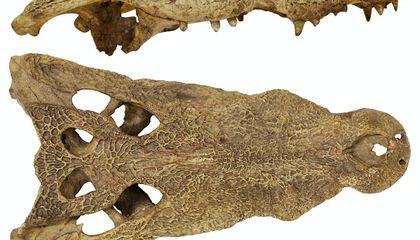
Most American crocodiles don’t need to look far to find the feature that sets them apart from Nile crocodiles. The difference lies right between their eyes and their nostrils. Of crocodiles living today, only the four crocodile species that live in the Americas have a small bump in the middle of their snouts.
But about seven million years ago, a ten-foot-long crocodile living in what’s now Libya had the same tell-tale lump, according to research published in Scientific Reports last week. A fossil skull of the extinct Crocodylus checchiai provides more evidence that crocodiles spread across the world by migrating from Australia, through Africa and finally to South America.
The fossil “fills a gap between the Nile crocodile in Africa and the four extant American species,” University of Turin paleoherpetologist Massimo Delfino says to Science News’ Carolyn Wilke.
The fact that crocodiles live on both sides of the Atlantic Ocean has long puzzled biologists trying to figure out which direction the giant reptiles migrated. Genetic research in 2011 provided molecular evidence that crocodiles migrated from Africa to the Americas, but fossil evidence was scant.
“The main problem for palaeobiologists is the rarity and fragmentary nature of fossil remains,” Delfino and co-author David Iurino told the Agence France-Presse by email.


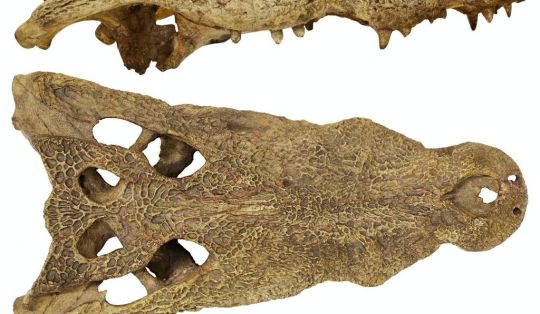

The seven million-year-old Crocodylus checchiai skull was first collected in 1939.
(Image by Bruno Mercurio)
The fossil described in the new paper is one of four that were first described in the 1930s. Three that were stored in the Natural History Museum in Tripoli, Libya, were lost or destroyed during World War II, according to the Scientific Reports paper. But the researchers found the fourth skull, originally collected in 1939, stored in the Sapienza University of Rome.
“This fossil is twice-old,” Delfino tells Nina Pullano at Inverse, referencing the fact that the skull is millions of years old and had then been forgotten for decades. The researchers used CT scanning to create a 3D model of the inside and outside of the skull for closer study and confirmed the presence of the American crocodile-like snout bump.
At seven million years old, the C. checchiai skull predates all known crocodile fossils in America, the oldest of which are about five million years old, Lucy Hicks reports for Science magazine. That means that the timeline checks out: it’s possible that C. checchiai may have made their way from Libya to the western coast of Africa, swam across the Atlantic and landed on the shores of South America.
The continents were about the same distance apart seven million years ago as they are today, making the journey across the ocean quite a feat—but not impossible. The researchers point out in a statement that the Australian marine crocodile has been recorded travelling more than 300 miles in a day. The prehistoric croc may have also bobbed along on one of the ocean’s surface currents that travel west from Africa to the Americas.
Crocodiles are also not the only flightless animal thought to have reached the New World by crossing the Atlantic. As the Inverse reports, a study published in April suggests that on two instances, monkeys made their way across the ocean on floating vegetation.
“If you think that the monkey can cross the Atlantic Ocean, very probably it’s much easier to accept that the crocodile can do it,” Delfino tells Inverse. Ancient crocodiles had the specialized glands necessary to swim and survive in saltwater and may have snacked on sea turtles along the way.
As a changing climate wiped out local species, crocodiles were well adapted to the late-Miocene environment and replaced them, the researchers write in the paper. The original crew of ocean-crossing crocs may have included many individuals or at least one pregnant female, Science News reports.
And after situating themselves in South America, they evolved and diversified into the four species found in the Americas today. (Only the American crocodile and American alligator are found in the United States.)
But whether or not the crocodilians mourn their C. checchiai ancestors is hard to tell—they might just be crocodile tears, after all.
#News
66 notes
·
View notes
Text
Heracles inexpectatus
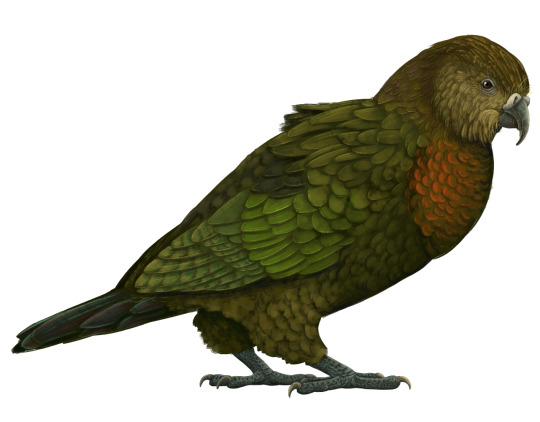
By Scott Reid
Etymology: For the Greek Demigod Heracles
First Described By: Worthy et al., 2019
Classification: Dinosauromorpha, Dinosauriformes, Dracohors, Dinosauria, Saurischia, Eusaurischia, Theropoda, Neotheropoda, Averostra, Tetanurae, Orionides, Avetheropoda, Coelurosauria, Tyrannoraptora, Maniraptoromorpha, Maniraptoriformes, Maniraptora, Pennaraptora, Paraves, Eumaniraptora, Averaptora, Avialae, Euavialae, Avebrevicauda, Pygostaylia, Ornithothoraces, Euornithes, Ornithuromorpha, Ornithurae, Neornithes, Neognathae, Neoaves, Inopinaves, Telluraves, Australaves, Eufalconimorphae, Psittacopasserae, Psittaciformes, Strigopoidea
Status: Extinct
Time and Place: Between 19 and 16 million years ago, in the Burdigalian of the Miocene

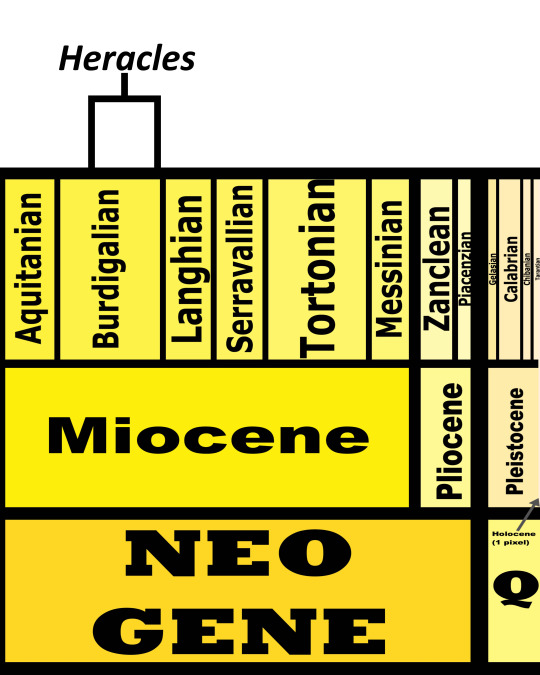
Heracles is known from the Bannockburn Formation of the South Island of New Zealand
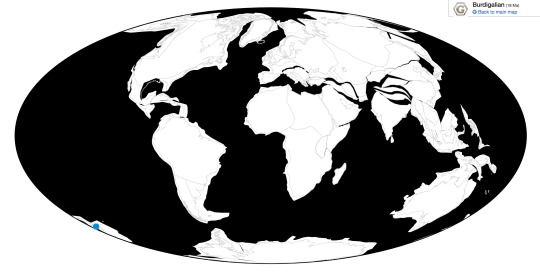
Physical Description: Heracles is an utterly fascinating recent dinosaur discovery, both for its inherent qualities and those due to the circumstances of its discovery. This was a large, Kākāpō-like parrot, about the height of a shorter adult or a child. It is the largest known parrot, and it would have been about one meter tall and weighing about seven kilograms. Given this size, it was flightless, and probably mostly terrestrial. It had a very strong beak, and probably resembled in many ways a giant version of the modern-day Kākāpō, Kaka, and Kea. As such, it would have been quite fat looking, probably greenish in color, and very fluffy as well.

By Brian Choo, Press Release Image
Diet: As a parrot, Heracles is most likely to have fed on seeds and nuts, though the fact that it was closely related to the living Kea means there is a non insignificant chance it was carnivorous. For now, we’ll say it was most likely an omnivore.
Behavior: It is logical to presume that Heracles resembled its modern relatives, which means it would have been a loosely social animal, spending most of its time on the ground in groups of about a dozen animals. It would have been able to use tools to get at sources of food, especially difficult to reach ones. It possibly would have also used its sharp beak to attack other dinosaurs on the island, chasing them with a hopping gait until they were isolated and then killed. An intelligent animal, it would have been able to solve puzzles and work together to get at sources of food or shelter. As a member of the New Zealand Parrot Group, it probably would have been polygamous, with the males having multiple mates at a time. They would have made nests on the ground, and since they never came across with mammalian predators, they probably would have been fine in terms of reproduction rate.

By Ripley Cook
Ecosystem: The Saint Bathans Fauna was a unique ecosystem filled with almost entirely birds, and other creatures that could float or fly over to New Zealand after it emerged from having flooded. This meant that birds were filling niches that, in the rest of the world, were being taken up by mammals. In short, this was a weird sort of Jurassic Park - with dinosaurs wreaking havoc as echoes of their former reign. Dinosaurs of the Saint Bathans Fauna included another New Zealand Parrot, Nelepsittacus, a bittern Pikaihao, herons like Matuku and Pikaihao, the swimming flamingo Palaelodus, flightless rails such as Priscaweka and Litorallus, the early Adzebill Aptornis proasciarostratus, the pigeon Rupephaps, the stiff-tailed duck Dunstanneta, the early Kiwi Proapteryx, the small Manuherikia duck, and the early New Zealand Wren Kuiornis - just to name a few! Given that only sparse remains are known from some unnamed birds of prey, this points to Heracles being at least somewhat carnivorous and fulfilling that role in its ecosystem. This was a series of extensive lakes, filled with cycad and palm trees, and there were also a wide variety of geckos, skinks, crocodilians, turtles, tuatara, and bats. There was one other mammal present - but, for now, we have no idea what it was.

By José Carlos Cortés
Other: The Saint Bathans Fauna is one of the most fascinating ecosystems of fossil birds of the Cenozoic Era. The unique ecosystem of New Zealand, with its almost complete lack of mammals before human interference. Heracles is an extremely important fossil find, as it may help us to piece together how the weird New Zealand Parrots evolved - previously, little was known in the way of fossil members of this group beyond recent history. The more we research it, the more we will be able to understand one small piece of the evolutionary puzzle that is this unique island. Also, it’s common name is Squawkzilla.
~ By Meig Dickson
Sources Under the Cut
Mather, Ellen K.; Tennyson, Alan J. D.; Scofield, R. Paul; Pietri, Vanesa L. De; Hand, Suzanne J.; Archer, Michael; Handley, Warren D.; Worthy, Trevor H. (2019-03-04). “Flightless rails (Aves: Rallidae) from the early Miocene St Bathans Fauna, Otago, New Zealand”. Journal of Systematic Palaeontology. 17 (5): 423–449.
Scofield, R. Paul; Worthy, Trevor H. & Tennyson, Alan J.D. (2010). “A heron (Aves: Ardeidae) from the Early Miocene St Bathans Fauna of southern New Zealand.” (PDF). In W.E. Boles & T.H. Worthy. (eds.). Proceedings of the VII International Meeting of the Society of Avian Paleontology and Evolution. Records of the Australian Museum. 62. pp. 89–104.
Tennyson, Alan J. D.; Worthy, Trevor H.; Scofield, R. Paul (2010). “A heron (Aves: Ardeidae) from the Early Miocene St Bathans fauna of southern New Zealand. In Proceedings of the VII International Meeting of the Society of Avian Paleontology and Evolution, ed. W.E. Boles and T.H. Worthy”. Records of the Australian Museum. 62: 89–104.
Worthy, Trevor H.; Lee, Michael S. Y. (2008). “Affinities of Miocene Waterfowl (anatidae: Manuherikia, Dunstanetta and Miotadorna) from the St Bathans Fauna, New Zealand”. Palaeontology. 51 (3): 677–708.
Worthy, Trevor H.; Tennyson, Alan J. D.; Hand, Suzanne J.; Scofield, R. Paul (2008-06-01). “A new species of the diving duck Manuherikia and evidence for geese (Aves: Anatidae: Anserinae) in the St Bathans Fauna (Early Miocene), New Zealand”. Journal of the Royal Society of New Zealand. 38 (2): 97–114.
Worthy, T. H., S. J. Hand, M. Archer, R. P. Scofield, and V. L. De Pietri. 2019. Evidence for a giant parrot from the Early Miocene of New Zealand. Biology Letters 15:20190467
#Heracles#heracles inexpectatus#Parrot#New Zealand Parrot#Dinosaur#Dinosaurs#Birds#Bird#palaeoblr#birblr#psittaciformes#Australavian#factfile#Terrestrial Tuesday#Omnivore#Australia & Oceania#Neogene
248 notes
·
View notes
Photo

Almost-Living Fossils Month #20 -- Some Very Spiky Turtles
The meiolaniformes were a group of terrestrial turtles that first appeared in the fossil record in the Early Cretaceous, around 125 million years ago. Although they were originally thought to be cryptodirans, more recent studies suggest they weren’t actually quite true turtles at all, instead being close evolutionary cousins to them in a much older and more “primitive” lineage that may go back as far as the Triassic.
They’re known mainly from South America and Oceania, but they may have had a more global distribution during the Cretaceous, with some fossils from the northern continents sometimes being classified as members of the group. However, only the South American meiolaniformes seem to have actually survived through the end-Cretaceous extinction.
The most distinctive meiolaniformes were the heavily armored meiolaniids, which first appeared in Patagonia during the Early Eocene (~48 mya). With large horns on their heads and thorn-like spikes along their long tails, they seem to have convergently evolved to fill the same sort of large-herbivore-tank niche as ankylosaurs and glyptodonts.
They also had fairly large nasal cavities, which might indicate a well-developed sense of smell -- or may have been an adaptation for regulating the heat and moisture content of each breath, similar to the complex noses of ankylosaurs.
The South American meiolaniformes all went extinct around the end of the Eocene (~33 mya), but some meiolaniids had already dispersed across to Australia via Antarctica (before the continents had fully separated, and before Antarctica had frozen over) and they continued to survive there for most of the rest of the Cenozoic. They even went on to spread to various islands around Oceania, suggesting they were able to float and swim like modern giant tortoises.
The largest Australian meiolaniids reached sizes of around 2.5m long (8′2″), making them some of the biggest of all known terrestrial turtles. These giant forms went extinct in the Late Pleistocene, around 50,000 years ago, alongside much of the other Australian megafauna.
A few smaller varieties hung on in smaller islands to the east, with one of the latest-surviving species being Meiolania platyceps on Lord Howe island. It was only about half the size of its biggest Australian relatives -- an example of insular dwarfism -- and lived into the Late Holocene just 3000-2000 years ago.
Meiolania species on other islands seem to have gone extinct after the arrival of humans. But Lord Howe Island appears to have never been inhabited prior to European settlement in the late 1700s, so it’s unclear why this last of the meiolaniformes disappeared.
[Edit: A new study of Meiolania platyceps’ anatomy suggests it may have been more aquatic than previously thought. It might have been something like a giant herbivorous snapping turtle or an armored reptilian hippo, bottom-walking around in coastal lagoons, with its big nasal cavity housing salt glands.]
#almost living fossils month#science illustration#paleontology#paleoart#palaeoblr#meiolania#meiolaniidae#meiolaniformes#testudinata#pantestudines#turtle#stem-turtle#archosauromorpha#reptile#art#ancient mutant fossil turtles#turtle power
331 notes
·
View notes
Text
Guess What? More Plastic Trash

Industry figures show record production in 2021, and almost none of that plastic is getting recycled.
When Exxon Mobil announced a record $56 billion annual profits[1] last week, it noted that the company had established “one of the largest advanced recycling facilities in North America, capable of processing more than 80 million pounds of plastic waste per year.” That seems like a lot of recycling muscle, except when you consider another figure. The company produced an estimated 6 million metric tons, or 13.2 billion pounds, of polymers used to make plastic in 2021 alone. That is an estimate from a report published by the Minderoo Foundation[2], set up by the Australian mining magnate Andrew Forrest[3]. Minderoo tracks plastic waste and campaigns against it.
Exxon is the largest producer of virgin polymers, which are derived from petrochemicals and used in plastic. The second largest is a Chinese company called Sinopec.
Asked for comment on the Minderoo report, an Exxon spokeswoman said that “plastics play a vital role in everyday life” and that the company is trying to scale up recycling. “By working with others in industry, governments, communities and consumers, we are helping expand recycling programs so that more plastic waste is transformed into valuable products rather than ending up in landfills.”
Despite consumer concern, we are trashing more and more plastic.
Plastics production continued to grow, according to industry data. So did plastic trash: 139 million metric tons in 2021, more than ever before. That’s a lot, especially considering that plastic entered our everyday lives after World War II. They’re so pervasive that when one reporter tried to spend a day living without plastic, it yielded this delightfully absurd essay.[4]
Almost all of that 139 million metric tons of plastic is made from “virgin” petroleum products that have never been used or processed before. Barely 2 percent gets recycled, Minderoo researchers estimated.
Plastic waste is more than a local environmental pollutant.
It clogs streams. It chokes turtles. It gets caught on a bare branch and blows in the breeze. It stews in landfills.
But it is also a climate pollutant. From the extraction of fossil fuels to make polymers to the transport and disposal of the waste, single-use plastics produced 450 million metric tons of planet-warming greenhouse gases in 2021 alone, according to estimates by Minderoo, or just below the annual emissions of Britain[5].
Minderoo is pressing for levies on “fossil-fuel polymer production and/or consumption” to fund the collection and recycling of plastic waste.
What about those triangles and arrows on plastic products?
They’re deceptive. Many of us assume the ♺ triangle means we can dispose of the product in our municipal recycling bins. Not so. Each triangle has a number within. Numbers 1 and 2 are commonly recyclable in the United States. For Numbers 3-7, it’s sometimes, rarely or never. (California banned the use[6] of the symbol on plastics that are not widely recyclable.)
Rigid plastics are more likely to be recycled than soft plastics. Some of the worst kinds of plastics are also those products that are marketed to the poor, especially in the global south, like tiny, low-priced sachets for shampoos and creams. They’re made of soft, thin plastic that’s hard to collect, sort and recycle.
Here’s our guide from last year[7], and an earlier Climate Forward newsletter[8] that describes how some cities outside the United States are handling plastic waste.
And the plastic bag bans?
There have been many such bag bans in recent years. Among the unexpected consequences: They seem to lead to an increase in plastic trash bags.[9] We’re keeping an eye on negotiations for a global plastics treaty. This is the battleground where plastic producers, environmentalists and negotiators from every country are hammering out what is intended to be a global agreement [10]to deal with plastic waste.
The big tension is between environmental campaigners who want to curb the production of polymers, the raw goods that go into plastic, and industry groups that want to focus on how to better collect and recycle plastic.
At negotiations in Uruguay in December, the United States advocated for an accord like the Paris climate agreement [11]under which countries would set their own national voluntary targets and plans. Others, including the European Union, want mandatory global regulations for every country and company to abide by.
The next round of negotiations are in May. We’ll keep you posted.
Source
Somini Sengupta, Guess What? More Plastic Trash, in: New York Times, 7-02-2023, https://www.nytimes.com/2023/02/07/climate/plastic-waste-recycling.html?smid=nytcore-ios-share&referringSource=articleShare
[1] https://corporate.exxonmobil.com/investors/investor-relations/quarterly-earnings
[2] Established by Dr Andrew Forrest AO and Nicola Forrest AO in 2001, Minderoo Foundation is proudly Australian, and one of Asia Pacific’s largest philanthropic organisations, with over AUD 2.6 billion committed to a range of global initiatives. The Plastic Waste Makers Index is a project of Minderoo’s Plastics initiative, which aims to create a world without plastic pollution – a truly circular plastics economy, where fossil fuels are no longer used to produce plastics. A critical step towards this goal is to bring greater transparency to the plastics supply chain – to better understand its material and financial flows, its environmental impacts, the commitments its companies have made to sustainability, and the effectiveness of government policies. https://cdn.minderoo.org/content/uploads/2023/02/04205527/Plastic-Waste-Makers-Index-2023.pdf
[3] Can a Carbon-Emitting Iron Ore Tycoon Save the Planet? Andrew Forrest made a mining fortune. Now he wants to lead a climate change revolution — and beat the fossil fuel giants along the way. https://www.nytimes.com/2021/10/16/business/energy-environment/green-energy-fortescue-andrew-forrest.html?smid=nytcore-ios-share&referringSource=articleShare
[4] Trying to Live a Day Without Plastic https://www.nytimes.com/2023/01/11/style/plastic-free.html?smid=nytcore-ios-share&referringSource=articleShare
[5] Greenhouse gas emissions, UK: provisional estimates: 2021. Measuring the contribution of the environment to the economy, the impact of economic activity on the environment, and society's response to environmental issues. https://www.ons.gov.uk/economy/environmentalaccounts/bulletins/greenhousegasintensityprovisionalestimatesuk/2021
[6] California Aims to Ban Recycling Symbols on Things That Aren’t Recyclable https://www.nytimes.com/2021/09/08/climate/recycling-california.html?smid=nytcore-ios-share&referringSource=articleShare
[7] Trash or Recycling? Why Plastic Keeps Us Guessing. https://www.nytimes.com/interactive/2022/04/21/climate/plastics-recycling-trash-environment.html?smid=nytcore-ios-share&referringSource=articleShare
[8] How Recycling Got So Baffling https://www.nytimes.com/2022/04/22/climate/plastic-recycling-climate.html?smid=nytcore-ios-share&referringSource=articleShare
[9] Are Plastic Bag Bans Garbage? https://www.npr.org/sections/money/2019/04/09/711181385/are-plastic-bag-bans-garbage
[10] The Plastic Problem https://www.nytimes.com/2023/01/06/climate/plastics-climate-pollution.html?smid=nytcore-ios-share&referringSource=articleShare
[11] More than 2,000 delegates from 160 countries, meeting in Uruguay in the first of a planned five sessions of the Intergovernmental Negotiating Committee (INC), aim to craft the first legally binding agreement on plastic pollution by the end of 2024. https://www.reuters.com/business/environment/countries-split-plastics-treaty-focus-un-talks-close-2022-12-03/
1 note
·
View note
Text
Australian Fakemon for the Canbora Region:
(australian opinions on this list would be greatly appreciated! <3)
Ice/Ground - Penguins
Dark/Fighting - Cassowary
Normal/Dark - Tasmanian Devil
Fairy/Ice - Southern Right Whale
Fairy/Poison - Platypus
Water/Ground - Buffalo
Grass/Ground - Bull
Ground/Fairy - Kiwi
Fairy/Ground - Echidna
Electric - Quoll
Flying/Fighting - Emu/Ostrich
Normal/Rock - Dingo
Fairy/Flying - Sugar Slider
Fire/Dragon - Thorny Devil
Rock/Fairy - Bilby
Rock/Normal - Numbat
Ground/Poison - Tarantula
Dark/Poison - Black Widow
Grass/Flying - Bat
Bug/Steel - Whip Scorpion
Rock/Ground - Tasmanian Tiger (Fossil)
Fairy/Fire - Galah Bird
Water/Ground - Crocodile
Fairy/ - Turtle Frog
Flying/Ground - Lyre Bird
Ghost/Flying - Barn Owl
Electric/Flying - Cockatoo
Electric/Fire - Red-eared Firetail Bird
Normal - Possum
Fairy/Normal - Pygmy Possum
Dark/Normal - Bandicoot
Electric/Poison - Jellyfish
Dark/Water - Octopus
Ghost/Water - Squid
Ground/Dark - Shark
Ice/Dark - Moray Eel
Water/Electric - Sea Krait Snake
Ghost/Normal - Slow Loris
Dark/Ground - Goanna
Rock/Water - Stonefish
Poison - Poison Dart Frog
Poison/Dark - Wagyl/Wirnpa/Akurra (legendary)
Fairy/Psychic - Dirawong (legendary)
Dark/Ground - Yowie (legendary)
Ghost/Dark - Bunyip (legendary)
Dark/Flying - Garkain (legendary)
Water/Dragon - Muldjewangk (legendary)
7 notes
·
View notes
Text
The Great Barrier Reef is Dying Faster then David Attenborough
As I turned off the godly voice of nature's Grandfather, Sir David Attenborough, I stared blankly at the wall ahead. A solemn tear trickled down my cheek as I wallowed in self-pity, eventually coming to a profound realisation… humans’ suck. While we’re complaining about the Woolworths plastic bag ban, the Great Barrier Reef is turning into an underwater wasteland. Overwhelming increases in carbon dioxide emissions are making our oceans warmer and more acidic (unless you are a Donald Trump enthusiast and in that case, Global Warming is just a hoax). In 2016, a rise in sea temperature and acidity spiked a major bleaching event which destroyed two-thirds of Australia’s Great Barrier Reef.
High school graduate Megan Sims looks out the window with a solemn expression on her face as she reminisces the Coral Monitoring and Turtle Rehabilitation program she recently participated. “Where we went there was a lot of coral rubble, which means that not only has the coral died but none has come through under that,” she says, her expression turning to anger. “I remember I was writing 50% coral rubble for most of the sights. It's just so upsetting because we were snorkeling in the most pristine part of the reef and it was still horribly damaged.” What Megan witnessed is what Professor Terry Hughes, director of the ARC Centre of Excellence for Coral Reef Studies calls “The worst mass bleaching event in history.” As human beings, we are the only species with the power to destroy the planet and the only ones who can save it. So, here is why we aren’t.
As a 20-year-old University student, Isabelle Siberling looks at the world with unwavering optimism and hope. Having recently traveled to Canada to take part in an International Entrepreneurial Social Justice Competition named World’s Challenge Challenge. Amongst waffles and maple syrup, Isabelle and her team established a social media education campaign named #icannsavethereef. There Isabelle developed five daily habits that an individual can change to limit their greenhouse gas emissions. The young environmental enthusiast says it is sending a message to Australians that there is a solution that they can reach individually. “They need to become the voice that the reef does not have,” says Isabelle. As true blue Aussies, why aren't we fighting for Nemo?
1. People are too set in their ways to make a change.
Life has never been more convenient. Need food? UberEats. Want clothes? Order online. Feel like a movie? Netflix and chill. However, as creatures of habit, we have become dangerously complacent and conditioned to our newly found lifestyle of ease and access, creating an epidemic of inertia. A study conducted by the Harvard Business School showed that people mainly resist change for the following reasons; a loss of control, disruption, and excess uncertainty. In the context of changing our lifestyles to support the survival of the reef, it becomes a matter of priority and sacrifice. How far are we willing to go to prevent an environmental catastrophe? Not that far apparently. “As individuals, we need to stand up and begin to make the small changes that send messages to big companies that we want to be more sustainable, we can make a huge impact by changing the smallest things that will hardly inconvenience us,” says Isabelle. As human beings, we are adaptable creatures and can easily make a lasting impact, according to psychiatrist Abigail Brenner. “We move from the passive state of just watching how things unfold to taking some action that enables us to utilise the change to create an outcome of our own choice,” says Dr. Brenner.
2. Out of sight out of mind
The Great Barrier Reef is the largest living structure on earth stretching for 2,300 kilometers along the Queensland coast. Isabelle sips through her reusable coffee cup as she remembers a childhood full of snorkels, laughter, and chafing. “Reef conservation is a passion of mine as I am originally from the Whitsundays which is alongside the Great Barrier Reef,” she says. “Growing up, I always had the opportunity to go out to the reef, which allowed me to see firsthand the deterioration in the condition of the reef and become passionate about saving it.” It’s not until we put on our scuba Steve costumes and see first hand the state of the reef that we can truly grasp the devastation. Dr. John Charlie Veron became the first Coral Reef Scientist in 1972 and discovered a third of the world’s known species. “I've been diving the same spots on the reef for 40 years, and over time I go back, and I am sickened by some of the changes I see,” He tells David Attenborough passionately. “Sometimes I go back to the same spot, and I can barely recognise it, some species have been wiped out from the shallows already.” Although the reef may seem to many as a far away underwater wonderland, the reproductions of its demise will impact everyone.
3. Capitalist Greed
Besides a decent kangaroo, the Great Barrier Reef is one of the leading tourist attractions in Australia. The Great Barrier Reef Foundation estimates the value of the reef is at a whopping $56 billion, with a total direct use benefit to domestic tourists at $29 billion, and overall direct use benefit to recreational vision $3 billion. The reality is that the reef is a substantial economic force, attracting two million visitors each year. Marine expert and Professor at James Cook University, Joshua Cinner, says the reef is a huge source of income for the Australian Government. “Market pressures for Australian reef fish now come from overseas; port dredging and shipping across the reef are spurred on by fossil fuel exports to Asia, and a housing crisis in the United States can batter reef tourism half a world away.” For the hundreds of businesses that rely on the reef, there remains a capitalist mentality that ensures the economy takes precedence over the impact on the environment.
4. Our impact feels Insignificant
Not using one plastic straw isn't going to make a difference, said seven billion people. It’s pretty straightforward, our oceans control the weather, the climate, the air we breathe. Without a healthy ocean, we do not have a healthy planet. As we go about our mundane lives, we remember that 7.2 billion people share this planet and that the significance of our existence is limited to 400 friends on Facebook. While this is extremely depressing, what is worse is the possibility of losing the reef, so buy a reusable bag and get over it. “Often, I find that people neglect the responsibility because they feel overwhelmed by the situation,” says Isabelle. ”When you begin to research into the issues that the reef is facing, it can feel as though there is no way to fix them. This can be disheartening and put people into a short-term headspace where they say that it 'isn't my problem' or 'someone else will find a solution. This is a dangerous way of thinking as individually; we can make a difference by taking steps towards protecting the environment.”
1 note
·
View note
Text
Rare 'Light-Footed' Dinosaur Discovered in Australia for the First Time
https://sciencespies.com/news/rare-light-footed-dinosaur-discovered-in-australia-for-the-first-time/
Rare 'Light-Footed' Dinosaur Discovered in Australia for the First Time

A previously mysterious fossil found in Victoria, Australia, has been identified as a rare, beaked dinosaur called an elaphrosaur, according to new research. Paleontologists have dated the specimen, first uncovered by a volunteer digger, to the Early Cretaceous, roughly 110 million years ago.
The name elaphrosaur means light-footed lizard, reports Sian Johnson for ABC News. Members of this small group of dinosaurs have long, slender necks, short arms and slight builds overall, explains Stephen Poropat, a paleontologist at Swinburne University of Technology and the lead researcher on the new paper in a statement.
“As dinosaurs go, they were rather bizarre. The few known skulls of elaphrosaurs show that the youngsters had teeth, but that the adults lost their teeth and replaced them with a horny beak. We don’t know if this is true for the Victorian elaphrosaur yet—but we might find out if we ever discover a skull,” Poropat adds.
Their toothsome youth suggests they may have gone through some kind of dietary shift with age, Poropat tells John Pickrell of the Guardian. But as their lack of fearsome chompers in adulthood suggests, elaphrosaurs were probably omnivores despite being theropods, which are cousins to Tyrannosaurus rex and other famous bygone carnivores, Steve Bursatte, a paleontologist at the University of Edinburgh who was not involved in the research, tells the Guardian. This particular elaphrosaur was probably just shy of seven feet long from nose to tail, according to the statement.
Elaphrosaurs are “really rare,” Poropat tells the Guardian. The elaphrosuars are a sparse lineage with just three named species that have been discovered in Tanzania, China and Argentina. “This is the first record of the group in Australia, and only the second Cretaceous record worldwide,” Poropat says.
Bursatte says the discovery of this specimen in Australia “greatly expands the range of these animals… They were probably a widespread, and perhaps even global, group of dinosaurs, which we haven’t yet appreciated because of the scanty clues they left behind.”

A fossilized vertebra, discovered by a volunteer digger in 2015 near Victoria, Australia, and subsequently identified as a type of dinosaur called an elaphrosaur.
(Stephen Poropat )
The fossil at the center of the new research, published earlier this month in the journal Gondwana Research, was first unearthed by dig volunteer Jessica Parker in 2015, per the statement. Parker spotted a “strange, delicate bone” roughly two inches long at a Cretaceous fossil bed known as Eric the Red West, near Cape Otway in Victoria.
Researchers initially pegged the fossil as a vertebra belonging to a pterosaur, a type of flying reptile, but closer examination revealed its surprising identity.
The slender, swift-footed elaphrosaur is also unique among its brethren for when it lived. Its relatives Elaphrosaurus from Tanzania and Limusaurus from Chin date from the late Jurassic (160-145 million years ago), but the Australian elaphrosaur lived around 40 million years later during the Early Cretaceous.
At that time, around 110 million years ago, Australia was located inside the Antarctic Circle and the fossil bed at Eric the Red West was home to a swiftly flowing river bordered by lush plant life, Poropat tells ABC News.
“There were conifer trees, things like modern-day monkey puzzles. There were ferns and lots of flowering plants,” he continues. The ancient riverbed has also preserved a jumble of bones from meat-eating dinosaurs, plant-eating dinosaurs, turtles and fish alongside the elaphrosaur, suggesting it was part of a diverse ecosystem.
The researchers are anxious to return to the Eric the Red West fossil bed soon, according to the statement, but their plans are on hold due to COVID-19 and had already been delayed once due to fire season.
Poropat praised the contribution of Parker, the volunteer who found the fossil. “As this story tells, one bone can change our understanding completely,” he tells ABC News. “If it belongs to a group of animals that we didn’t know was represented in Victoria, let alone Australia before, it can shape our understanding of the fauna.”
#News
#05-2020 Science News#2020 Science News#Earth Environment#earth science#Environment and Nature#Nature Science#News Science Spies#Our Nature#outrageous acts of science#planetary science#Science#Science Channel#science documentary#Science News#Science Spies#Science Spies News#Space Physics & Nature#Space Science#News
2 notes
·
View notes
Text
Kuiornis indicator

By Ripley Cook
Etymology: The Demigod Kui’s Bird
First Described By: Worthy et al., 2010
Classification: Dinosauromorpha, Dinosauriformes, Dracohors, Dinosauria, Saurischia, Eusaurischia, Theropoda, Neotheropoda, Averostra, Tetanurae, Orionides, Avetheropoda, Coelurosauria, Tyrannoraptora, Maniraptoriformes, Maniraptora, Pennaraptora, Paraves, Eumaniraptora, Averaptora, Avialae, Euavialae, Avebrevicauda, Pygostylia, Ornithothoraces, Euornithes, Ornithuromorpha, Ornithurae, Neornithes, Neognathae, Neoaves, Australaves, Psittacopasserae, Passeriformes, Acanthisitti, Acanthisittidae
Status: Extinct
Time and Place: Between 19 and 16 million years ago, in the Burdigalian of the Miocene


Kuiornis is from the Saint Bathans Fauna, a distinctive snapshot of the evolution of New Zealand’s unique birds - from the Bannockburn Formation of the South Island of New Zealand
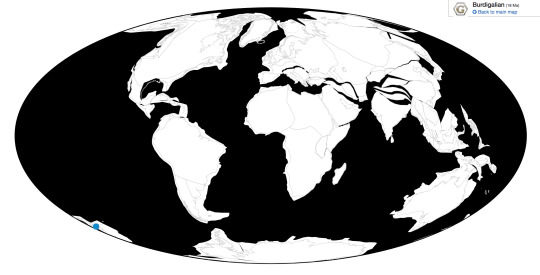
Physical Description: Kuiornis is known from limb elements, so we don’t know much about it, but it seems to have been only a little smaller than the living Rifleman, its closest relative - so it was probably around 7 centimeters long. It would have looked similar to the living Rifleman as well - a round bird, with a distinctively thin tail, and a small head with a triangular beak. As for differences from living New Zealand Wrens, it had differently formed and more compact legs. Beyond this, it’s difficult to say more about the specific appearance of Kuiornis; it probably would have been green and brown in color, like its living relatives.
Diet: Without fossil evidence of the beak, we have to assume that Kuiornis was an omnivore; given that New Zealand Wrens today favor invertebrates but still eat other forms of food, this is not an unreasonable assumption.
Behavior: Kuiornis would have been very skittish like modern New Zealand Wrens, flitting back and forth between the shrubs and vegetation in its habitat. It would have probably been only moderately social, like living New Zealand Wrens, and making high pitched, non-musical calls. Kuiornis would then spend most of its time foraging for food. When not doing that, it would have taken care of its young, building nests out of grass and in secluded spaces. It is difficult to say much about its breeding behavior - or behavior in general - however, since very little is known from this dinosaur.
Ecosystem: At the end of the Paleogene, New Zealand flooded. This completely erased the previous ecosystem, killing most things that had been on the island before that point. Afterwards, the only things that were able to colonize the space were creatures that floated over, and creatures that could fly. This included lizards and snakes and other reptiles, bats, and most notably of all - birds. New Zealand had one of the most unique avifaunas of all time, with many birds evolving to fill roles that mammals took in other locations - things like the moas, the large birds of prey, the adzebills, and living forms like the New Zealand Parrots that are like avian rodents and rabbits. The Saint Bathans Fauna is a snapshot of that initial colonization, showing how these unique birds began to diversify after New Zealand reemerged, in a lush lake enviroment. Kuiornis is just one part of that - showing the origin of the weird New Zealand Wrens. There was also the early Kiwi Proapteryx, the small Manuherikia ducks, the stiff-tailed Dunstanneta, the shelduck Miotadorna, the goose Cereopsis, the wood duck Matanas, the weird pigeon Rupephaps, the early Adzebill Aptornis proasciarostratus, the flightless rails Priscaweka and Litorallus, the swimming flamingo Palaelodus, the herons Matuku and Pikaihao, the bittern Pikaihao, the New Zealand Parrot Nelepsittacus, and potential eagles and hawks. There were also many geckos, skinks, crocodilians, turtles, and tuatara present as well. Weirdly enough, there was a mammal other than bats - but that mammal is what we would call a Mystery.
Other: Kuiornis has been extensively studied in phylogenetic analyses, and these analyses consistently recover Kuiornis as a New Zealand Wren, so it is an important find in understanding how this unique group of little dinosaurs evolved in such an isolated environment as New Zealand. Interestingly enough, it consistently comes out as very much nested in the group, extremely closely related to the Rifleman. This indicates that Kuiornis is not a decent model for the ancestor of the New Zealand Wrens, and also that advanced members of this group were present as recent as the mid-Neogene period.
~ By Meig Dickson
Sources under the Cut
Archer, Michael; Boles, Walter E.; Scofield, R. Paul; Worthy, Jennifer P.; Tennyson, Alan J. D.; Nguyen, Jacqueline M. T.; Hand, Suzanne J.; Worthy, Trevor H. (2010). "Biogeographical and Phylogenetic Implications of an Early Miocene Wren (Aves: Passeriformes: Acanthisittidae) from New Zealand". Journal of Vertebrate Paleontology. 30 (2): 479–498.
England, R. 2013. Recent advances in avian palaeobiology in New Zealand with implications for understanding New Zealand’s geological, climatic and evolutionary histories. Masters of Science Thesis, Massey University, Palmerston North, New Zealand.
Hand, SJ; Worthy, Trevor H.; Archer, M; Worthy, JP; Tennyson, AJD; Scofield, RP (2013). "Miocene mystacinids (Chiroptera, Noctilionoidea) indicate a long history for endemic bats in New Zealand". Journal of Vertebrate Paleontology 33 (6): 1442-1448.
Hand, Suzanne J.; Lee, Daphne E.; Worthy, Trevor H.; Archer, Michael; Worthy, Jennifer P.; Tennyson, Alan J. D.; Salisbury, Steven W.; Scofield, R. Paul; Mildenhall, Dallas C. (2015). "Miocene Fossils Reveal Ancient Roots for New Zealand's Endemic Mystacina (Chiroptera) and its Rainforest Habitat". PLoS ONE. 10 (6): e0128871.
Jones MEH; Tennyson AJD; Worthy JP; Evans SE; Worthy TH (2009). "A sphenodontine (Rhynchocephalia) from the Miocene of New Zealand and palaeobiogeography of the tuatara (Sphenodon)". Proceedings of the Royal Society B. 276 (1660): 1385–1390.
Mather, Ellen K.; Tennyson, Alan J. D.; Scofield, R. Paul; Pietri, Vanesa L. De; Hand, Suzanne J.; Archer, Michael; Handley, Warren D.; Worthy, Trevor H. (2019-03-04). "Flightless rails (Aves: Rallidae) from the early Miocene St Bathans Fauna, Otago, New Zealand". Journal of Systematic Palaeontology. 17 (5): 423–449.
Michael S. Y. L.; Hutchinson Mark N.; Worthy Trevor H.; Archer Michael; Tennyson Alan J. D.; Worthy Jennifer P.; Scofield R. Paul (2009-12-23). "Miocene skinks and geckos reveal long-term conservatism of New Zealand's lizard fauna". Biology Letters. 5 (6): 833–837.
Mitchell, K. J., J. R. Wood, B. Llamas, P. A. McLenachan, O. Kardailsky, R. P. Scofield, T. H. Worthy, A. Cooper. 2016. Ancient mitochondrial genomes clarify the evolutionary history of New Zealand’s enigmatic acanthisittid wrens. Molecular Phylogenetics and Evolution: 1 - 29.
Schwarzhans, Werner; Scofield, R. Paul; Tennyson, Alan J.D.; Worthy, Jennifer P.; Worthy, Trevor H. (2012). "Fish Remains, Mostly Otoliths, from the Non-Marine Early Miocene of Otago, New Zealand". Acta Palaeontologica Polonica. 57 (2): 319–350.
Scofield, R. Paul; Worthy, Trevor H. & Tennyson, Alan J.D. (2010). "A heron (Aves: Ardeidae) from the Early Miocene St Bathans Fauna of southern New Zealand." (PDF). In W.E. Boles & T.H. Worthy. (eds.). Proceedings of the VII International Meeting of the Society of Avian Paleontology and Evolution. Records of the Australian Museum. 62. pp. 89–104.
Scofield, R. Paul; Hand, Suzanne J.; Salisbury, Steven W.; Tennyson, Alan J. D.; Worthy, Jennifer P.; Worthy, Trevor (2013). "Miocene fossils show that kiwi (Apteryx, Apterygidae) are probably not phyletic dwarves". Paleornithological Research 2013 – Proceedings of the 8th International Meeting of the Society of Avian Paleontology and Evolution: 63–80.
Tennyson, Alan J. D.; Worthy, Trevor H.; Scofield, R. Paul (2010). "A heron (Aves: Ardeidae) from the Early Miocene St Bathans fauna of southern New Zealand. In Proceedings of the VII International Meeting of the Society of Avian Paleontology and Evolution, ed. W.E. Boles and T.H. Worthy". Records of the Australian Museum. 62: 89–104.
Tennyson, Alan J.D., Worthy, Trevor H., Jones, Craig M., Scofield, R. Paul & Hand, Suzanne J. (2010). "Moa's Ark: Miocene fossils reveal the great antiquity of moa (Aves: Dinornithiformes) in Zealandia". Records of the Australian Museum, 62 (1): 105–114.
Worthy, Trevor H.; Tennyson, Alan J. D.; Archer, Michael; Musser, A. M.; Hand, S. J.; Jones, C.; Douglas, B. J.; McNamara, J. A.; Beck, R. M. D. (2006). "Miocene mammal reveals a Mesozoic ghost lineage on insular New Zealand, southwest Pacific". Proceedings of the National Academy of Sciences. 103 (51): 19419–19423.
Worthy, Trevor H.; Tennyson, Alan J. D.; Jones, C.; McNamara, J. A.; Douglas, B. J. (2007). "Miocene waterfowl and other birds from central Otago, New Zealand". Journal of Systematic Palaeontology. 5 (1): 1–39.
Worthy, Trevor H.; Lee, Michael S. Y. (2008). "Affinities of Miocene Waterfowl (anatidae: Manuherikia, Dunstanetta and Miotadorna) from the St Bathans Fauna, New Zealand". Palaeontology. 51 (3): 677–708.
Worthy, Trevor H.; Tennyson, Alan J. D.; Hand, Suzanne J.; Scofield, R. Paul (2008-06-01). "A new species of the diving duck Manuherikia and evidence for geese (Aves: Anatidae: Anserinae) in the St Bathans Fauna (Early Miocene), New Zealand". Journal of the Royal Society of New Zealand. 38 (2): 97–114.
Worthy, Trevor H.; Tennyson, Alan J. D.; Archer, Michael; Scofield, R. Paul (2010). Boles, Walter E.; Worthy, Trevor H. (eds.). "First record of Palaelodus (Aves: Phoenicopteriformes) from New Zealand". Proceedings of the VII International Meeting of the Society of Avian Paleontology and Evolution; Records of the Australian Museum. 62 (1): 77–88.
Worthy, T. H., S. J. Hand, J. M. T. Nguyen, A. J. D. Tennyson, J. P. Worthy, R. P. Scofield, W. E. Boles, M. Archer. 2010. Biogeographical and Phylogenetic Implications of an Early Miocene Wren (Aves: Passeriformes: Acanthisittidae) from New Zealand. Journal of Vertebrate Paleontology 30 (2): 479 - 498.
Worthy, Trevor H.; Tennyson, Alan J. D.; Hand, Suzanne J.; Godthelp, Henk; Scofield, R. Paul (2011). "Terrestrial Turtle Fossils from New Zealand Refloat Moa's Ark". Copeia. 2011 (1): 72–76.
Worthy, Trevor H.; Tennyson, Alan J. D.; Scofield, R. Paul (2011-07-01). "Fossils reveal an early Miocene presence of the aberrant gruiform Aves: Aptornithidae in New Zealand". Journal of Ornithology. 152 (3): 669–680.
Worthy, Trevor H.; Tennyson, Alan J. D.; Scofield, R. Paul (2011). "An early Miocene diversity of parrots (Aves, Strigopidae, Nestorinae) from New Zealand". Journal of Vertebrate Paleontology. 31 (5): 1102–1116.
Worthy, T. H.; Tennyson, A. J. D.; Scofield, R. P.; Hand, S. J. (2013-12-01). "Early Miocene fossil frogs (Anura: Leiopelmatidae) from New Zealand". Journal of the Royal Society of New Zealand. 43 (4): 211–230.
Worthy, T. H., V. L. De Pietri, R. P. Scofield. 2017. Recent advances in avian palaeobiology in New Zealand with implications for understanding New Zealand’s geological, climatic and evolutionary histories. New Zealand Journal of Zoology 44 (3): 177 - 211.
Worthy, Trevor H.; Salisbury, Steven W.; Pietri, Vanesa L. De; Tennyson, Alan J. D.; R. Paul Scofield; Gunnell, Gregg F.; Simmons, Nancy B.; Archer, Michael; Beck, Robin M. D. (2018-01-10). "A new, large-bodied omnivorous bat (Noctilionoidea: Mystacinidae) reveals lost morphological and ecological diversity since the Miocene in New Zealand". Scientific Reports. 8 (1): 235.
#Kuiornis indicator#Kuiornis#Bird#Dinosaur#New Zealand Wren#Perching Bird#Passeriform#Birds#Dinosaurs#Palaeoblr#Birblr#Factfile#Omnivore#Songbird Saturday & Sunday#Australia & Oceania#Neogene#paleontology#prehistory#prehistoric life#biology#a dinosaur a day#a-dinosaur-a-day#dinosaur of the day#dinosaur-of-the-day#science#nature
157 notes
·
View notes
Text
ANIMALS
Ten Most Powerful Animal Bites on the Planet
Fearsome Apex Predators with the Strongest Jaws in the World.
— Steven Hill/Field and Stream | August 23, 2019 | Popular Science
Wild animals bring many awe-inspiring physical traits to their battle for survival, including the ability to use their teeth and jaws for self-defense and feeding. Not surprisingly, nature’s strongest jaws often belong to apex predators who sit comfortably atop the food chain, and collecting hard data on the force of their bites can be a decidedly risky proposition. Researchers have used a number of methods, from direct measurement to computer software modeling, to estimate the forces at work in nature’s bite club. Expressed as PSI (pound-force per square inch, a pressure of one-pound of force applied to a surface area of one square inch), here’s how some of the strongest jaws in the wild stack up.
1. Saltwater Crocodile

Saltwater crocs have the highest bite force ever recorded. Cultura Creative/Alamy
Bite Force: 3,700 PSI
Dr. Gregory Erickson, professor of anatomy and paleobiology at Florida State University and curator of the school’s Biological Science Museum, conducted a 10-year study to scientifically measure jaw strength in all 23 crocodile species. Erickson and his team placed a specially designed bite force transducer—which he likens to “an expensive bathroom scale” wrapped in “protective layers of bullhide”—between the jaws of multiple crocodile specimens. The highest reading, 3,700 PSI, was registered by a 17-foot saltwater croc. “It’s the highest bite force ever recorded,” Erickson says, “beating a 2,980-PSI value for a 13-foot wild American alligator.”
Notably, the team’s data allows projections of bite-force strength in now-extinct crocodiles found in the fossil record, including 40-footers estimated to have been capable of generating 23,000 pounds of force. That surpasses estimates for Tyrannosaurus rex, which Erickson estimated, in a 2017 study, probably had a bite force around 8,000 PSI.
“If you can bench press a pickup truck, you can escape a croc’s jaws,” Erickson says. Otherwise, “It is a one-way street between the teeth and the stomach of a large croc.”
2. Great White Shark

A breaching great white attacks a seal. Sergey Uryadnikov/Alamy
Bite Force: 4,000 PSI
In 2008, a team of Australian scientists led by Steve Wroe used sophisticated computer modeling based on multiple x-ray images of shark skulls to estimate that a 21-foot great white shark can produce nearly 4,000 PSI of bite force. Because bite strength in sharks is highly dependent on size; the much more common 11- to 15-foot great whites would pack considerably less punch than a similarly sized croc. And Wroe’s projections, unlike Erickson’s findings, have not been directly measured in field tests. Volunteers, anyone?
3. Hippopotamus

Hippos are capable of biting crocodiles in half. David Fettes/Alamy
Bite Force: 1,800 PSI
With tusks that can grow two feet long, a mouth that opens 180 degrees, and a bite that can crush a whole watermelon like a grape, hippos likely have the strongest jaws of any herbivore on the planet. Territorial and potentially aggressive, hippos are particularly hostile to crocodiles and are said to be capable of biting a 10-foot croc in half. The bite force of females have been measured at 1,800 PSI; males have reportedly proven too aggressive to test.
4. Jaguar

A jaguar feeding on its prey. Alan Tunnicliffe/Alamy
Bite Force: 1,500 PSI
The largest cat in the Americas is also the strongest biter of any wild feline. Unlike all other cats, which mostly go for the throat to dispatch their prey, the jaguar kills by biting its victim’s skull and is capable of puncturing a turtle’s shell with its teeth.
5. Gorilla
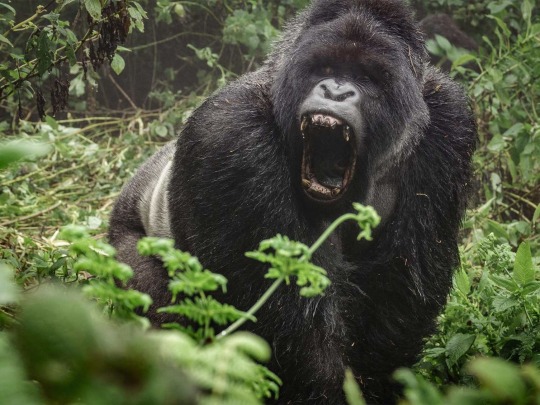
Gorillas are mostly herbivores, but have a powerful bite force. Francisco de Casa/Alamy
Bite Force: 1,300 PSI
It not so much the teeth, but the massive neck and jaw muscles that give the gorilla one of the most powerful bites in the primate kingdom. They’re herbivores, yes, but their diet includes much tougher stuff than bananas: The gorilla’s strong molars allow them chew heavy shoots, bark, nuts, tubers and other fibrous foods. Long, sharp canines seen in mature males are mostly for display.
6. Polar Bear

A polar bear feeds on a seal in Norway. ImageBROKER/Alamy
Bite Force: 1,200 PSI
Unlike most bears, whose teeth are designed to handle both flora and fauna, polar bears are exclusively meat eaters—hypercarnivore is the term. As a result, their bite is well adapted to dealing with the kind of prey they encounter in the Arctic: thick-skinned, heavily-feathered or, occasionally, North Face-clad. Polar bears are said to be the only mammal that actively hunts humans.
7. Spotted Hyena

A spotted hyena with the remains of a buffalo. Carol J. Saunders/Alamy
Bite Force: 1,100 PSI
Hyenas are skilled hunters that often make their own kills, but their tremendous jaw strength also allows these African mammals to profitably scavenge carcasses other predators leave behind. Dual-purpose teeth allow them to shear flesh and crush bone, and large jaw muscles combined with a unique arched structure that protects the skull against the forces generated by their own bite makes hyenas particularly efficient scavengers: When a hyena pack descends on a kill, there are rarely any leftovers.
8. Bengal Tiger

Tigers have a measured bite force twice that of lions. Mauritius images/Alamy
Bite Force: 1,050 PSI
Boasting the longest canine teeth (2.5 to 3 inches) of all cats, Bengal tigers present a fearsome display; they also have the force to back it up, delivering more than a thousand pounds-per-square inch of pressure—almost twice as much bite force as the king of the jungle.
9. Grizzly Bear

A fall grizzly in the Yukon Territories. ImageBROKER/Alamy
Bite Force: 975 PSI
Mythologized for their purported ability to decapitate a moose with a single swipe of their massive paws, grizzlies also have one of the more fearsome set of choppers in the wild. Doctors in bear country have developed antibiotic cocktails to fight the deep-tissue bacterial infections that survivors of grizzly bites often face. Their bite force is said to be strong enough to crush a bowling ball.
10. Lion

Though formidable, lions possess a bite force not much greater than a dog. Rodger Shearer/Alamy
Bite Force: 650 PSI
Lions have a bite force of only 650 PSI, which is not much stronger than the hardest-biting domestic dog, the English mastiff (550 PSI). But lions are social creatures that hunt in groups and consume their kill where it falls, which may lessen the need for individual jaw strength, some researchers have hypothesized. By comparison, humans exert a bite force of around 160 PSI when we clamp down—good enough to power through a tough steak sandwich, but nowhere near adequate for bringing a wildebeest to bay.
— This Article Was Originally Published on Field & Stream.
#Animals 🦔🦓🦒🦛🐊🦁🐆🐎🫏🐫🐪 🦍🦈🐻#Animal World 🌎#Powerful Bites#Fearsome Apex Predators#Strongest Jaws#Jaguar 🐆#Polar Bear 🐻❄️#Spotted Hyena
1 note
·
View note
Text
Some More Of Australia’s Famous Landmarks
There are so many amazing places in Australia! I have never been, but it is definitely on my bucket list an doing this research now, just makes me want to pack my bags and go right now! It seems there are so many places to see, the country has got varieties of different landscapes and makes even the desert and outback beautiful looking. Then there are of course the beaches, as Australia is said to have the most beautiful beaches in the world, and looking at the photos I would definitely agree!
The Great Barrier Reef
The largest living thing on Earth, what trip to Australia could be complete without swimming amongst the millions of fish, corals, and turtles that make this national treasure their home. Global warming and intensive use of the surrounding land might be slowly killing it – so don’t put it off and assume that one of Australia’s greatest tourist attractions will be there forever.

Kangaroo Island
This chilled-out, rural island off the coast of South Australia is sometimes called ‘Australia’s natural zoo’. Why? Well, here you can see native wildlife doing their thing out in the open.
About a third of the island is protected by national parks and conservation areas so the wildlife has been able to flourish. See a huge variety of birds, colonies of sea lions, spot the dolphins in the water and, of course, spend some time with the kangaroos that give the island its name. As an added bonus, some of the world’s best hotels are here and the food is perfection.
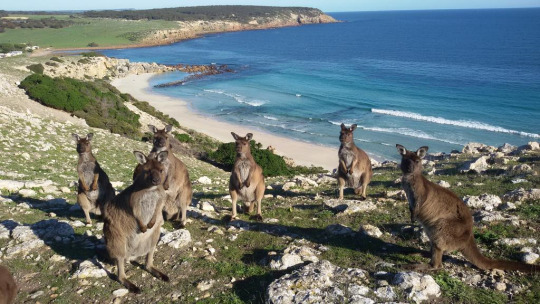
Cradle Mountain Tasmania
Found within the world-famous Cradle Mountain-Lake St Clair National Park, a hike along the Overland Track will bring you to the iconic Cradle Mountain, one of the most beautiful mountains in the world.
Proclaimed UNESCO World Heritage along with the surrounding area as part of the Tasmanian Wilderness World Heritage Area there is much more to explore in this special – and ancient – place including glacier feed river, tall pine forest, icy streams and even Tasmanian devils if you’re lucky!
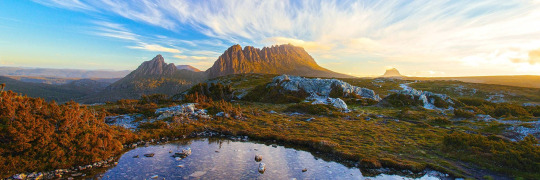
Broome
it’s quite a trek to this out-of-the-way town in the red-soil country of Western Australia and some people think it’s not worth it. However, it’s the ideal place to explore the region from, plus there is a lot more to Broome than meets the eye. A welcoming local community with a laidback vibe makes this seaside resort on the Indian Ocean charming year-round, not only when the tourists are piling in.
Cable Beach is glorious whatever the weather, and its west-facing location means that the sunsets are spectacular. You can also enjoy a film at the 1903 outdoor theatre, visit nearby Coconut Wells, go on a guided tour of the former pearling town, or drive out to the epic Cape Leveque. Exploring the creeks and mangroves of Roebuck Bay is also a lovely way to spend a morning (if it’s not too hot!). Quirky bars and cafes line the streets, and you’ll find that if you’re here for more than a couple of days you can quickly become a regular.

Uluru Rock
Speaking of isolated, this gorgeous, grand and utterly unforgettable monolith rising out of the vast desertscape has to be on everyone’s list of the most iconic Australian Landmarks. In the heart of arid Australia, the nearer town is 450 km away (Alice Springs) but that doesn’t spot thousands of tourists descending annually to this UNESCO World Heritage Site.
Uluru is over 550 million years old and is considered sacred to the indigenous Australians – so don’t even think about stepping foot on it! Admire for a distance, and try exploring the rest of the Uluru-Kata Tjuta National Park including the 36 red-rock domes of the Kata Tjuta…Yes, there are a few other things to do out here in the middle of nowhere!
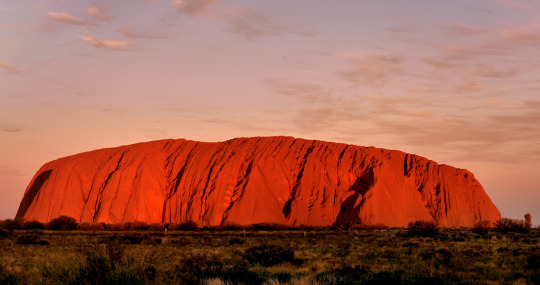
Fraser Island
Given that Fraser Island is heritage listed and absolutely stunning, not to mention the biggest sand island in the world, we’re sure you’ll understand why it’s on this list. Not for nothing do local Butchalla people call it paradise – it’s all deep blue lake, luscious golden sand dunes, rich rainforest and the ever-present ocean surrounding it all.
Coming here is a real adventure, something you sense as you bounce along unsealed roads in a four-wheel drive, spotting the local dingo. The wilderness on Fraser is full of native wildlife and the most popular accommodation option is camping, so you can really immerse yourself in the nature around. Float down Eli Creek, swim in the freshwater lakes (avoid the sea as the sharks love this area!) and hike to your heart’s content.
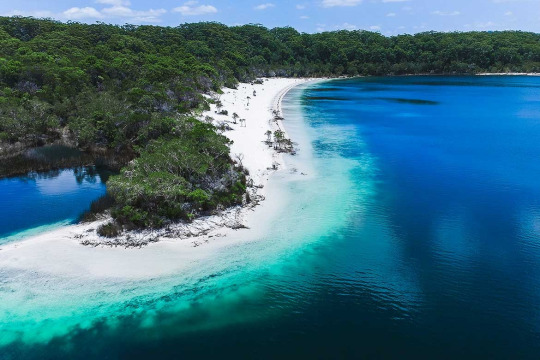
Kings Canyon
People might sometimes avoid central Australia on their road trips, but there are so many gems to discover there – Kings Canyon being one of the most spectacular. This vast cavern is a paradise for hikers, and really for anyone who loves to experience the wonders that the natural world can produce. Located in the heart of Watarrka National Park, this red-rock canyon offers jaw-dropping views of the sunrise from the top (well worth waking up pre-dawn!).
We’d recommend staying a couple of days here so you have the time to explore it on foot. Due to the heat, you often need to save the hiking for mornings are late afternoons, which is when the area is looking its best, anyway. The ripples in the rock show how the geology formed over millennia, from being underwater to finding its current home in the middle of this massive country. If you stay at the resort, you can enjoy dinner underneath the starry skies above Kings Canyon.

Blue Mountains
Only 90 minutes from Sydney, this iconic Australian natural landmark offer dramatic views over a seemingly endless Vally, though if you dare to explore further you fill find glow worm tunnels, more bushwalks than we can count, rivers, little cottages, leeches, and the worlds steepest railway.
While there are so many things to do near Sydney, if you can spare the time you really should try spending a few days in the Blue Mountains of Australia to escape it all, reconnect with nature – or at least just enjoy the cool, fresh air up here!

The Pinnacles Desert
Back into the desert again and another of the most iconic landscapes in Australia. The otherworldly Pinnacles Desert looks like a cross between the moon and a Star Wars film set, but it is actually one a few hours drive from Perth (though you do have to get there first).
Some of the oldest living fossils on Earth have been found here, a testament to how old these limestone spires really are and the mysteries held beneath Western Australia’s largest sand dunes.
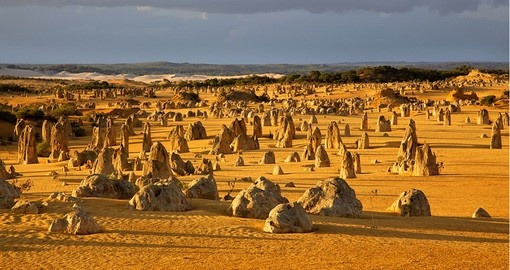
The Great Ocean Road
Probably one of the most scenic drives in the world – The Great Ocean Road is often first up on road-tripping tourists bucket list of iconic landmarks in Australia.
Hugging the coast of South Australia its not just about the drive, but about the surf breaks waterfalls, rainforest, galleries, heritage attractions and native wildlife you will encounter along that way. And that’s all before you set sight on the towering 12 Apostles, basically, the physical manifestation of rugged Australia splendor piercing out of the dramatic Southern Ocean.
We loved road-tripping here with friends, but in that case, things are going to be comfortable so be sure to follow some fabulous suitcase packing tips. If you have extra time, don’t forget to visit the nearby Yarra Valley for some of Australia’s best wineries…
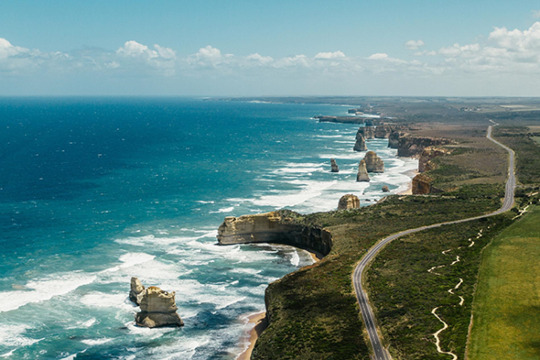
Byron Bay
No list of places to go in Australia would be complete without the famous Byron Bay. This town in south-eastern Australia has become practically synonymous with the laid-back, beachy surfer lifestyle that the country is invariably associated with. While its popularity has had its downsides (traffic jams, queues and a lack of parking space spring to mind as examples), this beach-focused town is still a special stop on your Oz road trip.
An eclectic group of people call Byron Bay their home – from artists and musicians who have set up camp here, to local retirees, to aging hippies looking to put down roots. This community mixed with the backpackers, families, and adventurers who visit creates a colorful, friendly place to be. Cafes hum with life, fresh food is lapped up, beers are enjoyed at sunset. If you’re feeling energetic, wake up at dawn for the glorious sunrise. Byron is not somewhere you’ll ever forget, trust us.
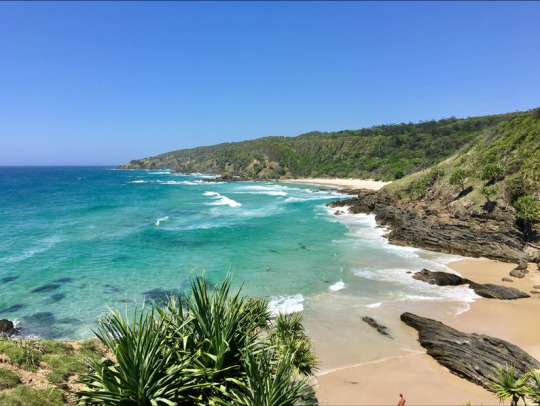
The Sydney Opera House
Not only one of the most iconic Australian landmarks, but one of the most famous buildings in the entire the world – The Sydney Opera House is a great architectural work of the 20th century and today listed as a UNESCO World Heritage Site (one of the youngest in the world.). Fusing creativity, innovation and structural design in a remarkable setting at the heart of the Sydney Harbour, this work by Danish architect Jørn Utzon inspired millions of people every year who come here to eat, drink, play, be entertained or simply admire this modern wonder of the world.

1 note
·
View note
Text
Day 3&4 swimming with sharks 🦈
Day 3 consisted on feeding dolphins, seeing some old rocks, and driving. We started off the day by going to a place called monkey mia dolphins. At this place a family of dolphins swims up to the shallow water, about knee deep. When they were there people could feed them fish. each dolphin would get about four fish and when the fish was gone they would dump a bucket of water into the ocean and the Dolphins knew this was the signal for no more food. They would then swim into deeper waters and wait for the next feeding. When they hear people walk into the water as a big group they know it is time for their next meal. The staff who ran this had to have a bucket behind all the people filled with fish that distracted the pelicans LOL because they wanted the fish too! After seeing the dolphins we drove to an area where we saw tons of rocks out of the water called stromatolites. These rock formations are some of the worlds oldest and largest living fossils, if you are a geology geek it's pretty cool. At this time we were still being attacked from flies like we were covered in garbage ( probably smelled like it from the heat). I started to notice a lot of people with nets around their entire head that tied off tight at the neck. These people were messing around with the flies ha ha After we left the rock formations we drove some more until we arrived at our hostel for the night. This was another large room with about 10 beds in it. The hostel provided food which was nice, and the whole crew sat and was watching some Australian football in the bar of the hostel. After dinner a lot of people were tired, but I knew I would only be on this trip once so once again I stayed awake with the Irish ladies. We decided to walk down the street to a pub where we found live music playing and it was great. The last song they played was Wonderwall and he did a pretty good job singing it I would say 👊🏼 when he finished singing we walked back to the hostel where I then found one guy from Sweden and the other guy from Japan who were on our trip hanging out looking for something to do. We decided to walk down to the beach at night time to see what it looked like. I would find by the end of the trip that these two guys would be some of my better friends, even though we had a very strong language barrier and my friend from Japan barely spoke any English. We were really good with hand gestures ha ha. We then got back to the hostel and went to bed because we were getting up pretty early the next morning to go snorkeling and searching for whale sharks, the biggest fish in the ocean. The next morning half of the group went whale sharking while the other half did things like snorkeling with the turtles and or just relaxing on the beach. I was about to find out that this might have been the most thrillseeking adrenaline junkie thing I have ever done. We suited up with our snorkel gear and our flippers and hopped on the boat. I found out that the two girls who would be our snorkel guides I had played ping-pong with the night before and they were pretty cool girls so I was excited for the trip. We started the trip off by heading out into the reef where we jumped straight into the water and just did snorkeling over lots of the Ningaloo Reef. This was my first time ever snorkeling and it was the coolest thing I think I've ever done. Being able to swim next to fish right over a coral reef was amazing. And the tour guide told us we were lucky and she had never experienced what was about to happen next.... about three minutes into the snorkel we saw a giant stingray about the size of two family pleaser Monicals pizza's playing in the sand. And about 30 m ahead in the reef we were swimming with four reef sharks. This is my first time swimming with something dangerous and the sharks looked like baby great whites or something to me ha ha. The scary part was she said they are normally that far into the reef which means there might have been something big out of the water… 🦈 After the snorkel with then were set on our trip to try and find a whale shark. It felt like we were in the boat forever waiting...and the waves kept getting rougher and rougher. The captain was in contact with a pilot who is flying over the waters over a 10 km span in an airplane Who is searching for a whale shark. It took us about three hours until we were told that they had spotted one and we would take the boat for 30 more minutes to find it. At this point half of our crew was extremely sea sick from the very choppy waves and people were throwing up all over the side of the boat or just laying down looking like they had the stomach flu.. my stomach felt a little weird, but luckily I've been on a roller coaster or two in my life and it didn't bother me, but watching my friends throw up all over the boat wasn't fun. Once we got to the area where the whale shark was the atmosphere just changed and everything seem to be very intense. The crew was split into two groups to get in the water and I was with the rest of the girls who I would be traveling with on my trip. The advice that we were given was once you get in the water the only thing that matters is when you see the shark swim to the left or to the right of it so you don't get hit by it straight on, seems easy right? Wrong. The very first jump we did into the water I was so nervous because I couldn't see the shark anywhere from the top before I got in and I had no idea where it was coming from or what to expect. I jumped in the water with about eight of my fellow travelers as we followed our guide about 30 feet from the boat. Remember the water was very choppy so it made things hard to see, I had my snorkel gear on but my head was above the water because I was trying to watch where my guide was taking us. The next thing I know she yells "SHARK" I put my head down immediately into the water, and I kid you not this enormous whale shark the size of a bus was swimming straight at me and was only about 20 feet away. My gut dropped and I was scared shitless as I stared at the thing coming straight at me like a deer in the headlights. I realized if I didn't move immediately my knee was going to hit it straight in the forehead head so I scrambled quickly to my left while the shark swim right past me. When it past me it was only about 10 feet away and the size of the shark made me feel like I was a minnow. Then I saw everyone chasing after it so I quickly swim after the shark and we followed behind it for about 100 feet, but he was swimming pretty fast and we were right behind him on his tail. Finally we stopped and waited for the boat to come pick us up to try and find him again. We then back onto the boat and sat down still breathing heavily because we just chased a shark through the ocean...I couldn't realize or take in what I had just done. The shark was about 7 m long or 21 feet to put things into perspective for you. It was an absolute tank and I stared it straight in the eyes from about 20 feet away. When we all got back into the boat we all looking at each other in shock and talking about how we all had no idea where it was coming from and how we all felt like we had to move right out of the way. Unfortunately, for some of the crew getting back on the boat meant they were immediately throwing up off the side again waiting to get back into the water. Two of the girls in my group were studs because they went from throwing up to putting their masks on and hopping in the water about 30 seconds after they threw up to go chase another shark. I had to give them some credit for that without throwing up in their snorkel gear LOL. We chased the shark four times and on the fourth and final time I had my closest encounter. The same thing happened as the first time I had hopped in the water, but this time I was looking around frantically trying to find him so I could be prepared and know where to get out of his way. But being the unlucky person I am, I had my back turned when he appeared out of nowhere and as I turned he was already 20 feet away. However, this time a girl was in front of me and so I didn't see him until he was so close I thought my knee was going to touch him. My stomach got really tight as I felt sick because I was afraid I was getting ready to kick this massive shark in the head. Our guides also had informed us we need to get out of the way and do not touch the shark because it will dive down deep and we won't be able to see it again. This all went through my mind very fast as the shark was quickly approaching. I surfaced to the water as fast as I could and got about 5 feet to the sharks right hand side before it went past me. This time I let everyone else chase the shark as I slowly just followed behind as all of these thoughts racing through my mind still I was trying to take in the fact that I almost once again had a head on collision with a whale shark. When we got back on the bus we had nothing but stories to tell to the rest of the crew. We were so excited that we saw a shark and we all thought it was the coolest thing we had ever seen. We then we're on our way to Yardi Creek. Where we would be camping the next two nights. We arrived at the campsite late at night so we had to find a tent and put everything in our tent in the dark. We then had spaghetti and sat around a campfire. At this point I decided I would stay up with whoever was awake every single night of the trip because you only get one opportunity sometimes in life and I wanted to hear as many stories and do as many cool things as possible. This night was very interesting because as we sat around the campfire I kept hearing a thumping noise out in the distance. I came to find out that I was hearing the noise of kangaroos hopping around in the dark. I found this funny because back home you hear coyotes howling at night time and where I was I could hear kangaroos hopping around with their buddies.
1 note
·
View note
Video
youtube
The Carnival of the Animals · Noël Coward · Andre Kostelanetz & His Orchestra / 安德 烈柯斯特蘭尼茲樂團 · Frank Miller · Julius Baker · Leonid Hambro · Jascha Zayde Speaker: Noël Coward Conductor: Andre Kostelanetz & His Orchestra / 安德 烈柯斯特蘭尼茲樂團 Cello: Frank Miller Flute: Julius Baker Piano: Leonid Hambro Piano: Jascha Zayde Composer: CAMILLE SAINT-SAËNS (1835-1921) Lyricist: Ogden Nash
From Wikipedia:
In 1949, Ogden Nash wrote a set of humorous verses to accompany each movement for a Columbia Masterworks recording of Carnival of the Animals conducted by Andre Kostelanetz. Recited on the original album by Noël Coward, they are now often included when the work is performed.
Introduction Camille Saint-Saëns Was wracked with pains, When people addressed him, As Saint Sanes. He held the human race to blame, Because it could not pronounce his name. So, he turned with metronome and fife, To glorify other kinds of life. Be quiet please - for here begins His salute to feathers, fur, and fins. Royal March of the Lion The lion is the king of beasts, And husband of the lioness. Gazelles and things on which he feasts Address him as your highoness. There are those that admire that roar of his, In the African jungles and velds, But, I think that wherever the lion is, I'd rather be somewhere else. Hens and Roosters The rooster is a roistering hoodlum, His battle cry is "cock-a-doodleum". Hands in pockets, cap over eye, He whistles at pullets, passing by. Wild Asses Have ever you harked to the jackass wild, Which scientists call the onager? It sounds like the laugh of an idiot child, Or a hepcat on a harmoniger. But do not sneer at the jackass wild, There is a method in his heehaw. For with maidenly blush and accent mild The jenny-ass answers shee-haw. Tortoises Come crown my brow with leaves of myrtle, I know the tortoise is a turtle, Come carve my name in stone immortal, I know the turtoise is a tortle. I know to my profound despair, I bet on one to beat a hare. I also know I'm now a pauper, Because of its tortley, turtley, torper. The Elephant Elephants are useful friends, Equipped with handles at both ends. They have a wrinkled moth-proof hide. Their teeth are upside down, outside. If you think the elephant preposterous, You've probably never seen a rhinosterous. Kangaroos The kangaroo can jump incredible, He has to jump because he is edible. I could not eat a kangaroo, But many fine Australians do. Those with cookbooks as well as boomerangs, Prefer him in tasty kangaroomeringues. Aquarium Some fish are minnows, Some are whales. People like dimples, Fish like scales, Some fish are slim, And some are round, They don't get cold, They don't get drowned. But every fishwife Fears for her fish. What we call mermaids They call merfish. People With Long Ears In the world of mules There are no rules. The Cuckoo in the Middle of the Wood Cuckoos lead bohemian lives, They fail as husbands and as wives, Therefore, they cynically dispariage Everybody else's marriage. Aviary Puccini was Latin, and Wagner Teutonic, And birds are incurably philharmonic, Suburban yards and rural vistas Are filled with avian Andrew Sisters. The skylark sings a roundelay, The crow sings "The Road to Mandalay," The nightingale sings a lullaby, And the sea gull sings a gullaby. That's what shepherds listened to in Arcadia Before somebody invented the radia. Pianists Some claim that pianists are human, And quote the case of Mr Truman. Saint Saëns, upon the other hand, Considered them a scurvy band. A blight they are, he said, and simian, Instead of normal men and womian. Fossils At midnight in the museum hall, The fossils gathered for a ball. There were no drums or saxophones, But just the clatter of their bones, A rolling, rattling carefree circus, Of mammoth polkas and mazurkas. Pterodactyls and brontosauruses Sang ghostly prehistoric choruses. Amid the mastodonic wassail I caught the eye of one small fossil, "Cheer up sad world," he said and winked, "It's kind of fun to be extinct." The Swan The swan can swim while sitting down, For pure conceit he takes the crown, He looks in the mirror over and over, And claims to have never heard of Pavlova. Finale Now we've reached the grand finale, Animale carnivale. Noises new to sea and land, Issue from the skillful band. All the strings contort their features, Imitating crawly creatures. All the brasses look like mumps From blowing umpah, umpah, umps. In outdoing Barnum and Bailey, and Ringling, Saint-Saëns has done a miraculous thingling.
11 notes
·
View notes
Text
How to Outsmart Your Peers on learning letters
The Ultimate Guide To Life Skills You Can Teach Your Kids At Home During
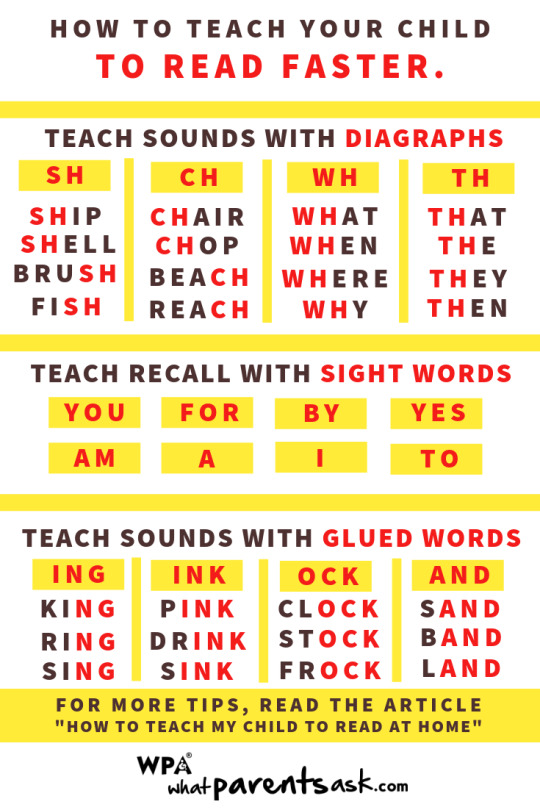
youtube
Incredible list curated by Jenny Rosenstrach (author of Dinner, a Love Story, amongst others) and Andy Ward, book agent extraordinaire. Has 2,000 math lessons for K-8 (Y1-Y9). It's an adaptive platform which users would usually need to pay for however you can register for 90-day complimentary trial here. Interactive math video games for ages 6-11 with quick-fire questions on everything from number bonds to increasing and dividing.
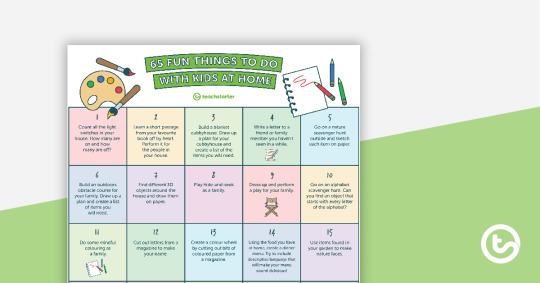
Solve math issues by collecting numbers while moving a marble through a series of mazes. In the Apple store. Extremely addictive. Uses off-screen, enjoyable activities to engage kids in building numeracy in manner ins which don't feel like school, focused on kids aged 3-9. (They also have iOS and Android apps.)Five-minute inquiries used to begin the day, take a break, or stimulate interest, with prompts like "Can turtles live outside their shells?" and "Why are rubies red?" Doug is a former grade school teacher who guides concerns, utilizes visuals, and asks concerns.
Have enjoyable and stay curious." Bless you, Doug. There's "discovery" about animals, science, history, and geography, then games with fun tests by topic (like dinosaurs, comets and meteors). However a real gem is "Primary Resources" which are discovering materials by subject (history, science, location, math, art and design, and PSHE, or personal social, health and economic education, which is a topic in the UK).
youtube
Development at its finest. Differentiated scientists blog about their advanced discoveries in accessible language for young readers, and after that kidswith the help of "science coaches"provide feedback and help the authors improve the short articles before publication. Subjects include brand-new advanced research (brand-new discovery) or core ideas, crucial ideas that are basic for understanding a clinical field.
The smart Trick of Home-school Parents Offer Tips To Teaching. That Nobody is Discussing
This typically matches researchers with classrooms, however there's a sign-up for families too. Among our coworkers says her 7-year-old son simply learnt more about fossils from taking part in this program.GEOgraphy Focus Maps, nation descriptions, flags, and more.Crash Course Children Fifth grade science made cool.Free School Brief videos about art, classical music, kids's literature, and life sciences.SciShow Children For more youthful kids (3-7) on whatever from coral reefs, why is fire hot to how to state goodbye.TheBrainScoop Emily Grassley, primary curiosity correspondent for the Field Museum in Chicago, shares the work and research study of natural history museums with the world.SciShow The tricks to what makes the universe tick.Science Max Science experiments at house. Learn more about"experiences in Raspberry Pi"or how to configure Python.Mike Likes Science Mathematics and science raps("you have two points on a line; you need an equation butit slipped your mind; slope-intercept is what you need; y= mx+b"). Need we state more? slogan is "Learn a language forever. Free."is complimentary for students for 3 months this spring. Teachers have begun offering classes online, such as these educational YouTube videos in English and Spanish.
One couple is hosting art lessons on YouTube at 2 pm ET for two weeks(beginning Mar. 16). Lessons will be archived. The beloved, acclaimed children 's book illustrator( Don't Let the Pigeon Drive the Bus!, Knuffle Bunny, etc.)invites kids to draw together with him daily at 1 pm ET on YouTube. Yeah, envision. Up until then, this site is loaded with creative projects, videos on photography, drawing, animation, and music. Connects instructors to kids for small video.
conference classes. From Shakespearian insults, fashion style through the ages, Harry Potter-themed chemistry, fractions, and the sociology of Disney bad guys, there's something for everyone. for kids and households from Typical Sense. You've become aware of March of the Penguins, but what about Infants? Or Imba methods Sing, 2 on offer?Fun? Maybe, maybe not. However definitely a beneficial life skill. Special deal now for Covid-19.
From telling the world to War (the card video game), this is an useful list of the obvious(rock-paper-scissors )and the not-so-obvious(shoe disarray). Make them provide more!Gordon Ramsay's Ultimate Cookery Course discover to prepare. Pineapple Street Studios is inviting kids to make a podcast about their experiences being, as the title says, stuck at house. Dance while developing a sweat. Tweens like this(hold a dance-off if the brother or sister competition will not fire up WWIII). Kids may be naturally feeling sorry for themselves. Help them help themselves by assisting others with greater needs. Charity Miles is a free US mileage tracker app that contributes cash to charities based on the number of miles you stroll, run, or bike. You understand you will be telling them, and retelling them, forEver. Will make everybody feel excellent. Produce a family server and get everyone on it for some co-creation. The his staple in lots of UK homes digests and bundles the news news for tweens and just landed in the United States.
9 Simple Techniques For Home-schooling For Kids
One Quartz's worker's 11 year-old reads the magazine cover to cover and loves the video games at the end. Produced by Vermont Public Radio and hosted by radio veteran Jane Lindholm, it interviews scientists, historians, and professionals of all stripes about some of the most important issues of our https://diigo.com/0jgbxy times. Do animals get married? How are noodles made? Why do we poop and fart? Grownups are guaranteed to discover something in each episode, and to actually enjoy listening. Eliminate any assumptions about woo-woo soul searching for the kindergarten set. Hosted by a yogi with an aggressively pleasant Australian accent and a big creativity, this is an indoor workout that's fun, needs no equipment(other.
than wifi and access to YouTube), and will get their wiggles out. Free not-for-profit with courses in mathematics at all levels, in addition to science, liberal arts, test preparation, and computing. Quizlet is an app for making flashcards and diagrams. Kids can design their own or find study sets that already have actually been produced, whether by their own teacher or someone else's. It's complimentary( you can, however, purchase research study guides created for specialized exams like AP tests, the MCATs, and the CFA), and kids can flawlessly change between mobile and desktop versions.
0 notes
Text
The Zoologist in me just got all excited. I’m quoting from various sources here.
Wolf and a turtle. Mammal and a reptile.
First we go to the Permian Period. The animals here are very cool.
Before the dinosaurs, for a time spanning 298 to 252 million years ago, landscapes across the planet were dominated by our distant predecessors and relatives. These were the synapsids—animals previously called “mammal-like reptiles” until paleontologists realized that this common term was all wrong.
These strange and unfamiliar creatures—adorned with sails, saber-fangs, and weird skull ornaments—were protomammals that were almost totally eliminated by a catastrophe that dramatically changed the course of life on Earth.
The Permian-Triassic extinction was our planets largest. Sometimes known as the great dying.
Then we can go modern. To the Monotremes. Egg laying mammals.
There are only five living monotreme species: the duck-billed platypus and four species of echidna (also known as spiny anteaters). All of them are found only in Australia and New Guinea. Monotremes are not a very diverse group today, and there has not been much fossil information known until rather recently.
If any of you are Potter fans. So we go magical.
Rowling describes the Niffler on Pottermore : “Fluffy, black and long-snouted, this burrowing creature has a predilection for anything glittery. Nifflers are often kept by goblins to burrow deep into the earth for treasure.
Which is just like a short nosed echidna.
Margot you are one lucky person.
---
Anthea’s Edit: And we link back to Australia. That first of all reminds me how the Australian swears the Niffler is just a platypus. That would make Margot very adaptive. - A.
3 notes
·
View notes